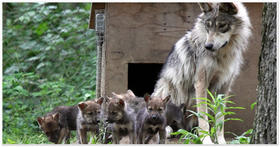State
wildlife officials have voted to increase the practice of
“cross-fostering” Mexican gray wolves. That’s the substitution of
captive-raised pups for wild ones in hopes of increasing genetic
diversity. Arizona Public Radio’s Ryan Heinsius reports.
Biologists
say inbreeding is a major threat to the endangered population in
Arizona and New Mexico. As of last month, 31 wild pups were counted
among the Southwestern packs. Two more pups were successfully
cross-fostered last year. Wildlife officials plan to triple that number.
“It’s a difficult task, but it can be done,” says Jim DeVos, assistant director of Wildlife Management for the Arizona Game and Fish Department. “And then we get wolves that grow up with wolves that are wild and that are doing what wolves do in the wild.”
The department’s commission, which is appointed by the governor, also voted to stop the release of captive-raised adult wolves. That has wildlife advocates concerned that cross-fostering alone won’t be enough to diversify wolf genetics.
“The truth is that cross-fostering is a very tricky, experimental technique, and it’s very difficult to find the right circumstances,” says Roxane George, board president of the Grand Canyon Wolf Recovery Project.
At last count, there were 110 Mexican gray wolves roaming the Southwest’s Blue Range Recovery Area.
source
“It’s a difficult task, but it can be done,” says Jim DeVos, assistant director of Wildlife Management for the Arizona Game and Fish Department. “And then we get wolves that grow up with wolves that are wild and that are doing what wolves do in the wild.”
The department’s commission, which is appointed by the governor, also voted to stop the release of captive-raised adult wolves. That has wildlife advocates concerned that cross-fostering alone won’t be enough to diversify wolf genetics.
“The truth is that cross-fostering is a very tricky, experimental technique, and it’s very difficult to find the right circumstances,” says Roxane George, board president of the Grand Canyon Wolf Recovery Project.
At last count, there were 110 Mexican gray wolves roaming the Southwest’s Blue Range Recovery Area.
source



No comments:
Post a Comment